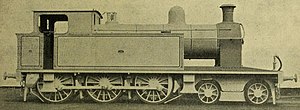The CBSCR Bandon Tanks were a class of 4-6-0T mixed-traffic locomotives built for the Cork, Bandon & South Coast Railway (CB&SCR) between 1906 and 1920.[2] The Bandon Tanks were the only 4–6–0 tank locomotives to be built by Beyer, Peacock & Company. The class went on to serve with the CB&SCR's successors: the Great Southern Railways from 1925 and CIÉ from 1945.
| CB&SCR 4-6-0T GSR Class 463 (B4) | |||||||||||||||||||||||||||||||||||||||||||
|---|---|---|---|---|---|---|---|---|---|---|---|---|---|---|---|---|---|---|---|---|---|---|---|---|---|---|---|---|---|---|---|---|---|---|---|---|---|---|---|---|---|---|---|
 Bandon tank | |||||||||||||||||||||||||||||||||||||||||||
| |||||||||||||||||||||||||||||||||||||||||||
| |||||||||||||||||||||||||||||||||||||||||||
| |||||||||||||||||||||||||||||||||||||||||||
| |||||||||||||||||||||||||||||||||||||||||||
The Bandon Tanks excelled due to their elegant design, high power output and compact wheel arrangement, which suited the track of the CB&SCR network.
Introduction and CB&SCR service
editThe 4–6–0T wheel arrangement was more typically found on narrow gauge lines, because the restricted bunker space (and resultant limited coal capacity) is less of a hindrance on the typically shorter journeys of such lines. A 4-6-2T wheel arrangement would have given more bunker space, but it would have been too long for the CB&SCR's turntables.[citation needed] The wheelbase was also short-coupled (close to each other) in order to manage the tight curves on the CB&SCR lines.[3] Each locomotive had capacity for two tons of coal and 1,100 gallons of water and weighed 56 tons 10 hundredweight.[2]
The first member of the class was 11 which was ordered in 1905, cost £3,145 and was delivered in June 1906.[4] The next to be built was 14, which was ordered in 1908, cost £2,575 and was delivered in March 1909.[4] These were followed by 15 in October 1910, 20 in July 1912 and 19 in June 1914.[4]
The CB&SCR ordered no. 4 in April 1915 but World War I restrictions prevented Beyer, Peacock from completing and delivering it until October 1919.[4] The two final members of the class were 8 and 13, which were delivered in November 1920.[1] Post-war inflation had trebled the price of these final two locomotives to £8,163 and £9,163 respectively.[1]
Operationally the Bandon Tanks were small and powerful locomotives, well regarded apart from the cramped cab and the difficulty of cab access due to the rear wheel splashers.[citation needed] Despite the bunker size being limited by the 4–6–0T layout, Bandon Tanks had no difficulty covering distances on the CB&SCR network,[2] the greatest of which was 62 miles (100 km) between Cork Albert Quay and Baltimore.[5]
GSR and CIÉ service and withdrawal
editThe GSR renumbered the class 463 – 470 and later designated it Class B4. Between 1935 and 1947 the GSR rebuilt five of the class with type "R" Belpaire superheated boilers.[6]
The majority of the class continued to work on the former CB&SC network, but in 1929 the GSR transferred 468 to Grand Canal Street depot[7] in Dublin for suburban service on the former Dublin & South Eastern Railway main line between Dublin Westland Row and Bray.[2] In 1939 first 470 and then 466 were also transferred to Grand Canal Street.[7] 469 replaced 466 on the Bray line for just over a year, from 1941 until 1942.[7] 466 became the last Bandon Tank in service on the Bray line, remaining there until September 1956.[7]
465 and 469 were withdrawn in 1945.[1] CIÉ withdrew 467 in 1959.[1] CIÉ withdrew 466, 468 and 470 in 1961,[1] the year that it closed the former CB&SCR network. 463 and 464 stayed in service until 1963,[1] which was CIÉ's final year of steam traction.
Livery
editIn CB&SCR service the class was painted olive green with yellow lining.[8] Throughout the period of Great Southern Railways operation (1925-45), along with all locomotives on the West Cork system (and further afield), they were all-over unlined dark grey, which was carried over into CIE days. In CIÉ service there was some variation in liveries.
- 466 was painted lined CIÉ green in December 1948.[7]
- 467 was a dark blue-green in 1953.[3]
- 470 was a dark matt off-black (likely to be a local variation of the standard dark grey livery) in 1954[3] and 463 was the same in 1962.[9]
- 464 appeared to be gloss black in 1961.[10]
Any others remained dark grey.
Model
editA 1:76 scale (OO and 21 mm gauges) nickel-silver kit is available from Studio Scale Models.[11] Both Belpaire and unsaturated versions can be made.
Notes
edit- ^ a b c d e f g h i j k l m n o Shepherd 2005, p. 148
- ^ a b c d e f g h i j k l Clements & McMahon 2008, p. 163.
- ^ a b c Boocock 2009, p. 43.
- ^ a b c d Shepherd 2005, p. 109
- ^ Shepherd 2005, p. 147.
- ^ Shepherd 2005, pp. 109–110.
- ^ a b c d e Shepherd 2005, p. 110.
- ^ Shepherd 2005, p. 112.
- ^ Ferris 1995, p. 37.
- ^ Patience 2006, front page.
- ^ "Loco Kits and Accessories". Studio Scale Models. Retrieved 15 December 2012.
Bibliography
edit- Boocock, Colin (2009). Locomotive Compendium: Ireland. Shepperton: Ian Allan Publishing. ISBN 978-0-7110-3360-3.
- Clements, Jeremy & McMahon, Michael (2008). Locomotives of the GSR. Newtownards: Colourpoint Books. pp. 162–163. ISBN 978-1-906578-26-8.
- Ferris, Tom (1995). Irish Railways in Colour: A Second Glance, 1947–70. Hinckley: Midland Publishing. ISBN 1857800192.
- Patience, Jack (2006). CIÉ 1958 to 1962. Irish Railway Photographers. Newtownards: Colourpoint Books. ISBN 1904242693.
- Shepherd, Ernie (2005). Cork, Bandon & South Coast Railway. Hinckley: Midland Publishing. ISBN 1-85780-198-9.